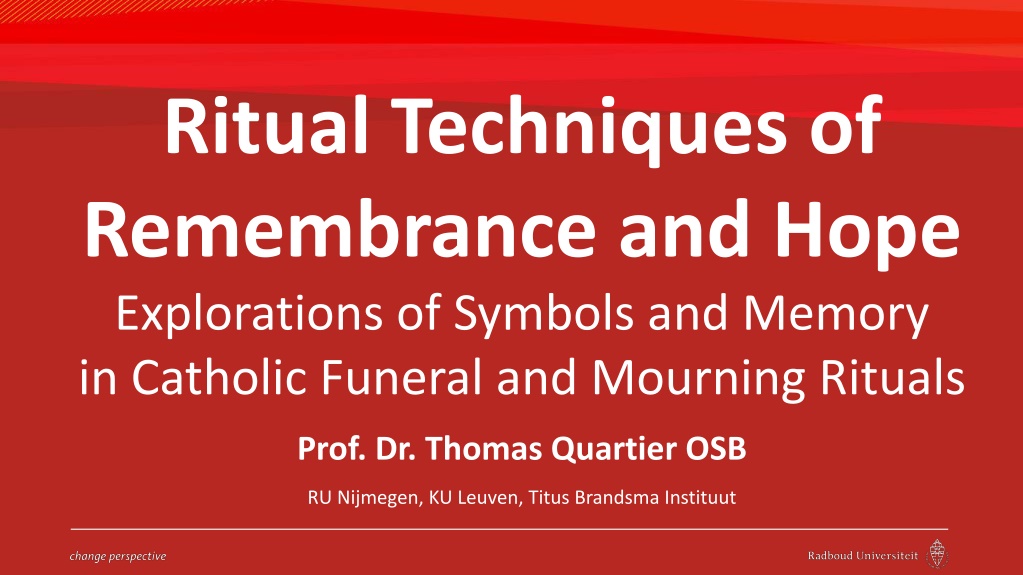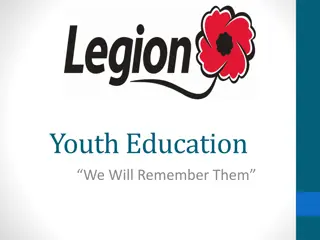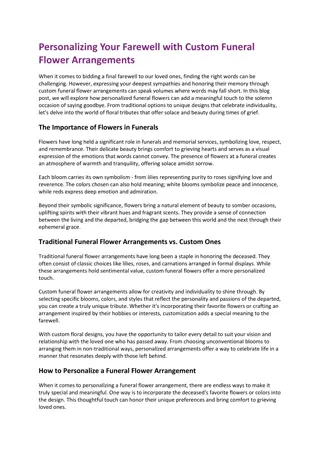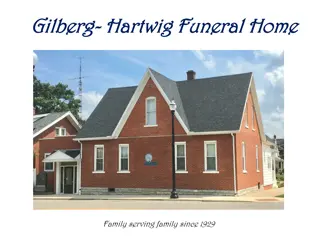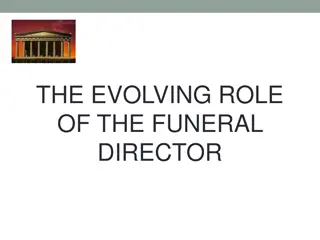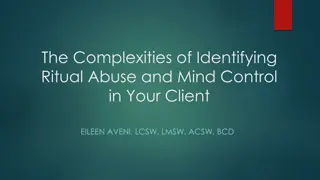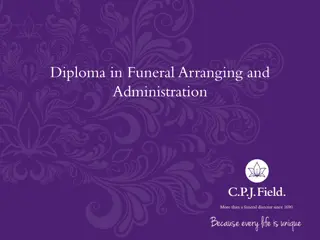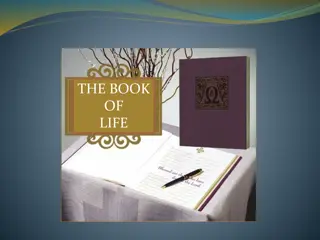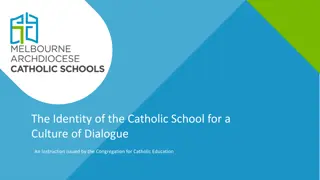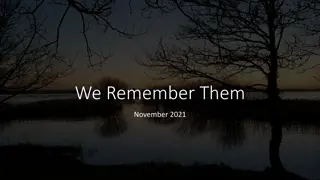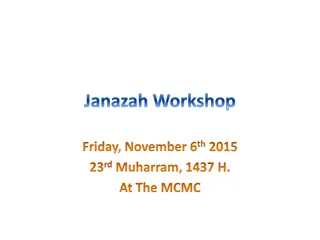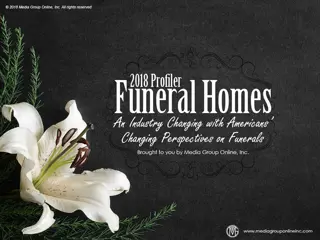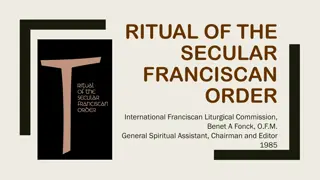Exploring Ritual Techniques of Remembrance and Hope in Catholic Funeral Rites
Delve into the significance of ritual techniques for remembering the deceased and symbolically transitioning bodily remains in traditional Catholic funeral rites. Discover how liturgical memory and symbols are shaped in this context, addressing the evolving needs of mourners in contemporary Western Europe.
Download Presentation

Please find below an Image/Link to download the presentation.
The content on the website is provided AS IS for your information and personal use only. It may not be sold, licensed, or shared on other websites without obtaining consent from the author. Download presentation by click this link. If you encounter any issues during the download, it is possible that the publisher has removed the file from their server.
E N D
Presentation Transcript
Ritual Techniques of Remembrance and Hope Explorations of Symbols and Memory in Catholic Funeral and Mourning Rituals Prof. Dr. Thomas Quartier OSB RU Nijmegen, KU Leuven, Titus Brandsma Instituut
Liturgical Rites out of Place? The less obvious element of a memorial event lies in its appearance within or as part of a funeral service. Traditional Christian funerals have not been memorial events . They have been seen as marking the transition of the deceased person from this earthly life into the future life of the world beyond. [ ] The liturgical tradition of thanksgiving is more for delivery from a vale of tears as for any joy experienced during life. Its rationale was, and for some remains, fine as long as the afterlife was postulated as a pleasure following pain, as long as it was reckoned to constitute life- fulfillment. But that is no longer the case for the vast majority of people in Western-Europe (D. Davies 2008, 61-62).
Research problem and main question Research problem: In traditional Catholic funeral and mourning rites, the ritual techniques of memory of the deceased and symbolic transition of the bodily remains do not meet the needs of remembering life in life and the ongoing presence of the deceased ( continuing bonds ). Beliefs in the hereafter are not shared by most funeral-goers and mourners; ritual memory seems not to be a major part of the rites. - - Main Question: How are the ritual techniques of liturgical memory (1) and symbols (2) given shape in Catholic liturgical books and how can their perception be interpreted in light of theories of ritual memory? - Method: Images from empirical studies on funeral and mourning rites (ritual studies); Images from liturgical formulars of Christian funeral and mourning rites (liturgical theology); Reciprocal illumination (Sharma)
1 - Liturgical symbols Louis Marie Chauvet (1995): Symbol and Sacrament Dimensions of symbols: cosmic; social; traditional. - Quartier (2009 etc.): Surveys among participants at mourning rituals show that they mainly long for continuity in the relation with the deceased, expressed in memorial words, gestures and objects. - Wojtkowiak (2009, 150-151): 34% of respondents had a home memorial for a deceased person. 93% of the respondents had a memorial place with a photograph of the deceased, 36% had candles and 24% had flowers. Objects related to the deceased s identity were found in 36% of cases. Almost half the people said they had felt or sensed the presence of the dead . How can a symbolic triangle of (post)self, group and tradition be built by liturgical symbols and personal symbolization?
1 Liturgical symbols Order of Christian Funerals (1991): Rite for the Burial of Ashes: My friends, we have come together to bury the ashes of our brother/sister N. In doing this we recall that our bodies bear the imprint of the first creation when they were fashioned from dust; but in faith we remember, too, that by the new creation we also bear the image of Jesus who raised to glory (215). Faithful God, Lord of all creation, you desire that nothing redeemed by your Son will even be lost and that the just will be raised up on the last day. Comfort us today with the word of your promise as we return the ashes of our brother/sister to the earth. Grant N. a place of rest and peace where the world of dust and ashes has no dominion. Confirm us in our hope that he/she will be created anew on the day when you will raise him/her up in glory to live with you and all the saints for ever and ever. Amen (216).
2 - Ritual memory Jan Assmann: On Cultural Memory (1995) - Quartier (2007 etc.): Surveys among funeral goers and participants at mourning rituals show that they mainly long for communicative remembrance; they are open for cultural hope. - Mathijssen (2017, 102): Our research emphasizes the lived nature of afterlife representations. In the process, traditional images of an afterlife are losing their prominence and exclusivity and are increasingly being assigned a multitude of meanings. Representations of the hereafter, both traditional and non-traditional, are not taken off a shelf ready for use, but are continually reimagined and re-articulated based on personal experience. It is this reimagining which gives meaning to life and death and to the death of a loved one in particular . How can a connective structure be built between the traditional ritual technique of liturgical prayer and ritualizing memory?
2 Liturgical memory Order of Christian Funerals (1991) Prayer of commendation Into your hands, father of mercies, we commend our brother/sister N. in the sure and certain hope that, together with all who have died in Christ, he/she will rise with him on the last day. We give you thanks for the blessings which you bestowed on N. in this life: they are signs to us of your goodness and of your fellowship with the saints in Christ (99). Prayer for the mourners Lord our God, the death of our brother/sister N. recalls our human condition and the brevity of our lives on earth. But for those who believe in your love, death is not the end, nor does it destroy the bonds that you forge in our lives (424).
Ritual Techniques of Remembrance and Hope Prof. Dr. Thomas Quartier [Thomas.quartier@ru.nl] Concept Questions Symbols - How can communicative memory of the deceased be articulated liturgically? - How can cultural memory of an afterlife of the deceased be articulated in liturgy? - How can situational beliefs accompany personal experiences of funeral goers and mourners? - How can the identity of the deceased be symbolized in funerals and mourning rituals? - How can the social identity of the assembly be symblized in a liturgical setting? - How can traditional symbolic patterns be a frame for symbolizing death and afterlife? Memory
